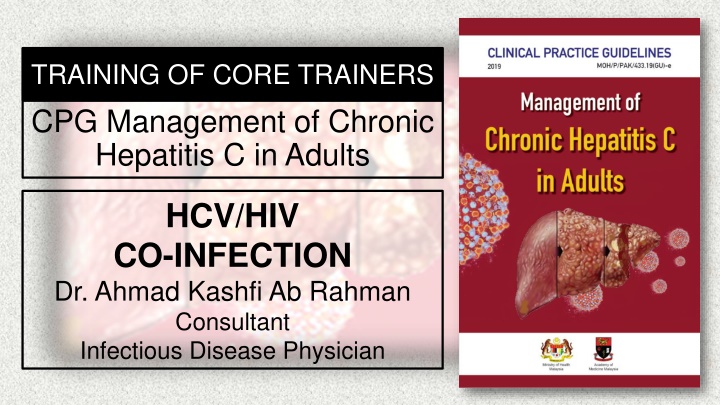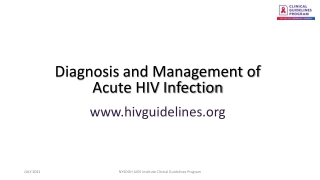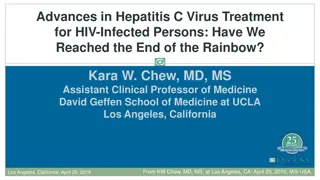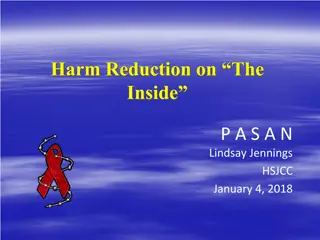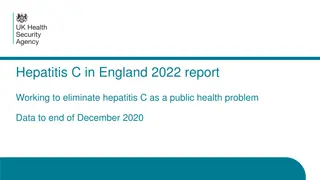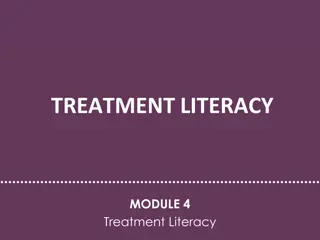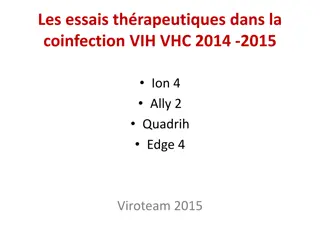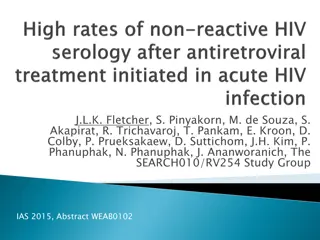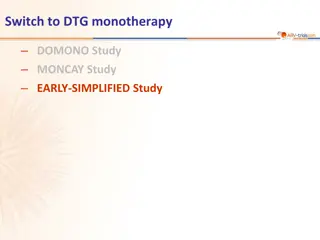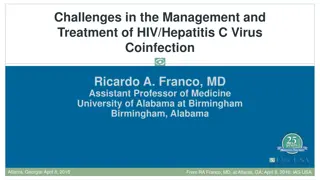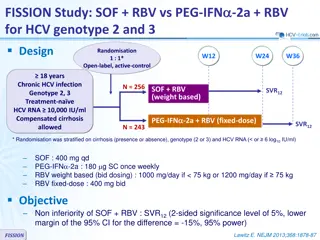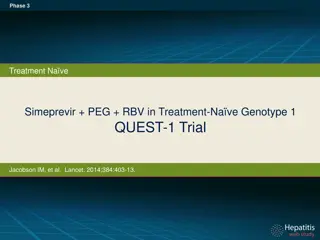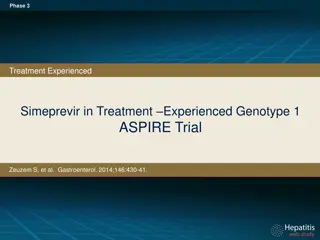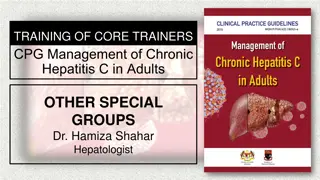Effective Management of HIV/HCV Co-Infection
Patients co-infected with HIV and Hepatitis C face higher risks of liver-related complications. Timely initiation of Direct-Acting Antivirals (DAAs) is crucial, along with managing potential drug interactions. Treatment efficacy has been comparable to mono-infected individuals, emphasizing the importance of early intervention for improved outcomes.
Download Presentation

Please find below an Image/Link to download the presentation.
The content on the website is provided AS IS for your information and personal use only. It may not be sold, licensed, or shared on other websites without obtaining consent from the author.If you encounter any issues during the download, it is possible that the publisher has removed the file from their server.
You are allowed to download the files provided on this website for personal or commercial use, subject to the condition that they are used lawfully. All files are the property of their respective owners.
The content on the website is provided AS IS for your information and personal use only. It may not be sold, licensed, or shared on other websites without obtaining consent from the author.
E N D
Presentation Transcript
TRAINING OF CORE TRAINERS CPG Management of Chronic Hepatitis C in Adults HCV/HIV CO-INFECTION Dr. Ahmad Kashfi Ab Rahman Consultant Infectious Disease Physician
Learning Objectives 1. To learn on: efficacy & safety of the direct-acting antivirals (DAAs) regime for HIV/HCV co-infected patients. timing to start DAAs in HIV/HCV co-infection. potential drug-drug interaction between DAAs & antiretroviral therapy (ART). 2
HIV Co-infection HIV/HCV co-infected patients are at higher risk to develop liver-related morbidity & mortality than HCV mono-infected patients. Having well-controlled HIV & restored immune function while on ART reduces the risk of liver disease progression due to hepatitis C. Co-infection will likely accelerate liver disease progression, therefore early hepatitis C treatment is beneficial. 3
HIV Co-infection -2 Fewer HIV/HCV co-infected patients have been treated in DAAs trials; 1. Sofosbuvir + Daclatasvir (SOF+DCV) The combination of SOF+DCV once daily for 12 weeks achieved SVR12 between 91% to 98% of treatment-na ve and treatment-experienced HIV/HCV.48 4 48. Wyles DL et al. N Engl J Med. 2015;373(8):714-25.
HIV Co-infection -3 2. Sofosbuvir/Ledipasvir (SOF/LDV) Studies had shown that SOF/LDV for 12 weeks were associated with high SVR12 rates of 96 - 100% in HIV/HCV co-infections.49 - 50 3. Sofosbuvir/Velpatasvir (SOF/VEL) SOF/VEL for 12 weeks is safe & achieves overall SVR12 of 95% including in compensated cirrhosis & treatment- experienced HIV/HCV co-infections.55 49. 50. 55. Milazzo L et al. HIV Med. 2017;18(4):284-91. Hawkins C et al. J Antimicrob Chemother. 2016;71(9):2642-5. Wyles D et al. Clin Infect Dis. 2017;65(1):6-12. 5
DAAs Efficacy in HCV/HIV Co-infected Person The effectiveness among this group has been remarkably similar to the HCV mono-infected group in the evidence discussed earlier. 6
When to start DAAs? People with HIV/HCV co-infection are advised to start ART soon after being diagnosed with HIV (WHO 2016). This is especially so if CD4 cell count is below 350 cells/ L; to improve immune function. Treatment of these patients requires special attention due to the complexity of drug-drug interactions (DDI) that can occur between DAAs & antiretroviral medications. HIV treatment should not be interrupted in order to start hepatitis C treatment. 8
DDIs - NRTIs SOF/DCV has no significant DDI with NRTIs. SOF/LDV increases tenofovir levels when given as tenofovir disoproxil fumarate (TDF), which may increase the risk of tenofovir-associated renal toxicity. SOF/VEL increases tenofovir levels when given as TDF, which may increase the risk of tenofovir-associated renal toxicity. o These combinations should be used with caution with close monitoring of renal profile in patients with an eGFR <60 ml/min/1.73 m2.28 10 28. AASLD-IDSA HCV Guidance Panel. Clin Infect Dis. 2018;67(10):1477-92.
DDIs - NNRTIs The dose of DCV should be increased from 60 mg to 90 mg when used with potent inducer of cytochrome P450 (CYP) 3A4 e.g. efavirenz (EFV), etravirine (ETV) or nevirapine (NVP). LDV s AUC decreases by 34% when co-administered with EFV- containing regimes. o Although no dose adjustments of LDV are recommended to account for these interactions, the combinations should be used with cautions & frequent renal monitoring.28 SOF/VEL is not recommended to be used in patients on EFV, NVP or ETV. 12
DDIs - Protease Inhibitors DCV should be decreased from 60 mg to 30 mg when used with CYP 3A4 inhibitor e.g. ritonavir-boosted atazanavir, cobicistat- boosted atazanavir or elvitegravir/cobicistat. The usual DCV dose should be used with ritonavir-boosted darunavir & ritonavir-boosted lopinavir.28 LDV s AUC increases by 96% when co-administered with ritonavir- boosted atazanavir. o Although no dose adjustments of LDV are recommended to account for these interactions, the combinations should be used with caution and frequent renal monitoring.28 SOF/VEL combination can be safely used in lopinavir/ritonavir- containing regimen. 14
DDIs - Protease Inhibitors -3 16 Source: John JF. A Quick Guide for Clinicians. April 2017.
DDIs - Integrase Inhibitors All available DAAs in the market have no significant DDI with integrase inhibitor group of antiretroviral (ARV). A standard dose of 60mg can be used. 17
DCV Interactions with Commonly Used Medications Among HIV Patients Medication and/or Class Recommendation & Clinical Comment Strong inhibitor of CYP3A Antibiotics - clarithromycin Decrease DCV dose to 30mg once daily Antifungals - itraconazole, posaconazole, voriconazole Moderate inducer of CYP3A Antimycobacterial - rifapentine Increase DCV dose to 90mg once daily Corticosteroids - dexamethasone Strong inducer of CYP3A Antimycobacterial - rifampicin Other medications Co-administration is not recommended Anticholesterol - atorvastatin, pravastatin, rosuvastatin Monitor for HMG-CoA reductase toxicity Opioid substitution therapy - methadone, buprenorphine Monitor for OST toxicity Source: John JF. A Quick Guide for Clinicians. April 2017. 19 19
Take Home Messages DAAs is as effective & safe in HIV/HCV co-infected as in mono- infected people. Treating underlying HIV before starting treatment of hepatitis C is preferable. The dose for DCV will vary according to different class of ARV. 20
THANK YOU THANK YOU 21
